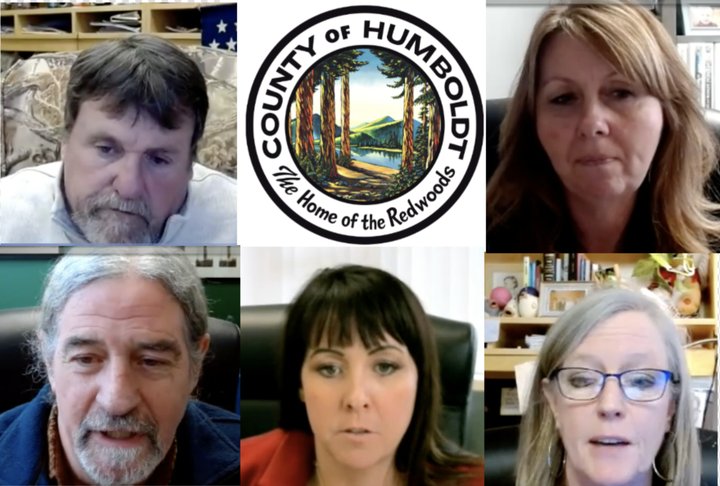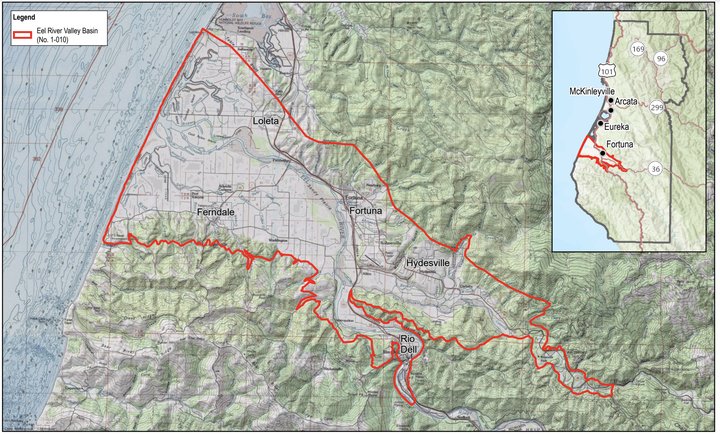
Screenshot from Tuesday’s meeting (clockwise from top left): First District Supervisor Rex Bohn, the county seal, Second District Supervisor Michelle Bushnell, Fourth District Supervisor Virginia Bass, County Administrative Officer Elishia Hayes and Fifth District Supervisor Steve Madrone.
###
We headline this (mostly) weekly report “TODAY in SUPES,” but occasionally the Humboldt County Board of Supervisors wears other hats, fulfilling duties as the governing board of some other agency. The process of transitioning from one government body to another always sounds a bit odd. The chair will say that the board is “adjourning as the Board of Supervisors” and “reconvening” as this other agency, though no one moves. The adjournment and reconvening happens abstractly, within the brains and designated authority of each individual board member.
Today was such an occasion, as the humans who have been elected supervisors heard an update about a state-mandated sustainability plan for groundwater in the Eel River Basin. (Minus one supervisor: Third District representative Mike Wilson was absent for today’s meeting.)
Therefore, the Lost Coast Outpost proudly [?] presents …
TODAY in the HUMBOLDT COUNTY GROUNDWATER SUSTAINABILITY AGENCY

Map of the Eel River Groundwater Basin. | Image via County of Humboldt.
Hank Seemann, the county’s deputy director of environmental services, delivered a lengthy and detailed update on the status of the Eel River Valley Groundwater Sustainability Plan. This plan, as noted above, is required by California law — specifically the Sustainable Groundwater Management Act of 2014.
That law says certain jurisdictions must form their own groundwater sustainability agencies, and in Humboldt County the supervisors fill that role. The plan itself, Seemann explained, provides a framework for managing the groundwater resources in that fertile valley for economic, social and environmental benefits. It must be submitted to the state’s Department of Water Resources by the end of the month.
Since groundwater is such a complex resource, developing the plan required extensive fieldwork, data collection, computer modeling, stakeholder consultation and professional evaluation. “This really was a big undertaking,” Seemann said.
The Groundwater Sustainability Plan must include a detailed water budget of inflows and outflows — an accounting of the Eel River Valley’s interconnected system of groundwater and surface water. County staff created a computer model to answer questions about the dynamics of that system, another very big undertaking, Seemann said.
One of the major goals of these sustainability plans is to identify “undesirable results” in the groundwater — poor storage, bad water quality, seawater intrusion, etc. — and lay out some measures to rectify those problems within a 20-year timeframe.
Agricultural uses — primarily irrigation of pastures and crops — represents 80 to 90 percent of groundwater usage in the basin, with municipal and domestic use accounting for much of the remainder. Of course, the water is also critical to fish-bearing streams (the Eel River is a migrating corridor for adult salmon and steelhead), riparian vegetation and wetlands.
“We’re really fortunate just in terms of our natural assets in Humboldt,” Seemann said. “The aquifers in the Eel River Valley are deep and productive. They can really store vast amount of water.” The groundwater levels are stable and replenish quickly, he added.
Still, the management plan has to include sustainable management criteria. The county plans to keep tabs via a system of monitoring wells with minimum thresholds, Seemann explained.
County staff intends to finalize the Groundwater Sustainability Plan in the next two weeks and bring the final plan back to the board on January 25 for possible adoption. The plan must be updated every five years.
After the presentation, First District Supervisor Rex Bohn said the county already has 60 years of well data that wasn’t given the consideration it deserves. “I’m less worried about saltwater intrusion than I am about government intrusion,” he quipped.
Second District Supervisor Michelle Bushnell said it seems like gravel pack in the river basin has increased noticeably in recent decades. Seemann said he’s not sure it’s changed significantly in recent decades, but the 1964 flood certainly caused a lot of alterations.
Fifth District Supervisor Steve Madrone commended Eel River Valley farmers for increasing their water conservation efforts.
After taking public comment, the Humboldt County Groundwater Sustainability Agency adjourned and the Board of Supervisors reconvened — without moving a muscle.
###
There wasn’t a whole lot else on the board’s agenda. The main item, which we previewed yesterday, concerned possible changes to the board’s agenda template.
Fourth District Supervisor Virginia Bass explained that as the board chair, she was interested in looking at ways to ensure the county’s business gets done during these meetings given the dramatic increase in public participation ushered in by Zoom technology and the polarized COVID-19 debates.
Should the public comment period on non-agenda items be moved to the afternoon? The end of the meeting? Should the time limit for each person to speak be cut from three minutes to two?
Such conversations are happening in counties across the state, Bass said. Kathy Hayes and Tracy D’Amico, the clerk and deputy clerk of the board, respectively, recently attended a statewide conference where “best practices” for public participation were discussed.
D’Amico said she also polled some other county governments to see how they’re handling the increased volume of public feedback. Seven of the nine counties that responded schedule the public comments on non-agenda items for the end of the meetings, after the rest of the business has concluded, D’Amico said. Boards can also adopt measures on the fly — say, by limiting public commenters to one minute apiece if 150 of them sign up to speak.
Bohn, Bushnell and Madrone all said they’d support whatever the chair decides to do, though Madrone later said he’d prefer to keep the public comment period at the beginning of the meeting while Bohn suggested moving it to the end and limiting people to two minutes apiece.
After deliberating back-and-forth a bit and hearing from the public — several members of which spoke to the importance of hearing from constituents — Bass made the decision to move public comments on non-agenda items to the end of each meeting while keeping the three-minute time limit in place.
CLICK TO MANAGE